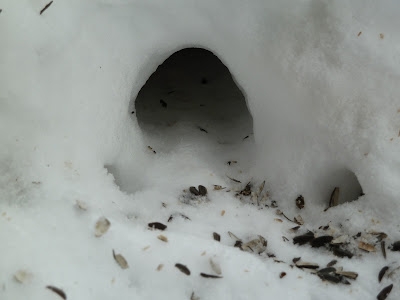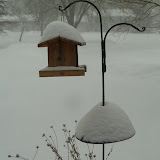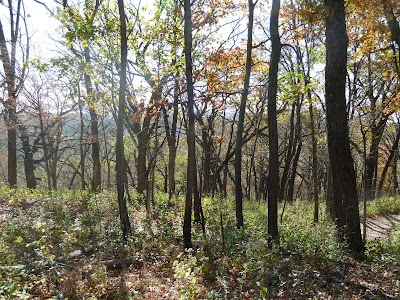 Update (Jan. 2014):
Update (Jan. 2014): This post, now three years old, is one of the most frequently visited posts I've written. The issue clearly comes up for people a lot. The comments contain some good points that helped me develop my views (and probably state them better), and so I encourage readers to read them too.
-----------------------------------------------
Readers with an editor's eye (perhaps I should say eagle-eyed readers) may have noticed that I've been less than consistent when it comes to the capitalization of the official English names for bird species, such as Northern Cardinal or Black-capped Chickadee (or, as it may happen, northern cardinal and black-capped chickadee).
In this, I'm reminded of my quandary over the use of the apostrophe in common terms like
farmers' market and
kids' meals, which I explored in some detail three years ago in a post titled
Tormented By an Apostrophe. (After some dithering, I came down firmly on the side of retaining the apostrophe despite a modern trend to do without it that is generally supported on the claim that the plural is being used purely as an adjective, not connoting possession; I was convinced to the contrary by applying the question to irregular plurals, concluding that we would not feel comfortable calling something a
children meal or looking for
women sizes in a department store.)
However, back to capitalization of bird names. There's a split here, basically between ornithologists and the rest of the writing world, except where style guides expressly defer to the common usage in a particular field. As a born editor and English usage junkie, I had to investigate further. (This is going to be a long one, so settle in...)
It's undisputed that the International Ornithologist's Union prescribes capitalization in the official English common names set forth in its definitive
IOC World Bird List:
Our goal on behalf of the International Ornithologist's Union, formerly International Ornithological Congress (IOC), is to facilitate worldwide communication in ornithology and conservation through the consistent use of English names linked to current species taxonomy. The English names follow explicit guidelines for spelling and construction that increase clarity of application. ...
An important rule adopted at the outset was that the words of an official bird[']s name begin with capital letters. While this is contrary to the general rules of spelling for mammals, birds, insects, fish, and other life forms (i.e., use lowercase letters), the committee believed the initial capital to be preferable for the name of a bird species in an ornithological context, for two reasons.
- It has been the customary spelling in bird books for some years;
- Because it distinguishes a taxonomic species from a general description of a bird. Several species of sparrows could be described as "white-throated sparrows," but a "White-throated Sparrow" is a particular taxonomic species.
I'd like to point out that the IOC World Bird List website,
worldbirdnames.org, is a marvel of clear, simple, precise writing (though not without a few typos), and I admire it very much.
I surveyed our collection of field guides at home, and found that every one (Sibley, National Geographic, Peterson, Audubon, Golden, and Tekiela) uses the IOC convention of capitalizing all words in a bird's common name except for a word following a hyphen in a hyphenated name, such as White-throated Sparrow.
This practice in the world of ornithology departs from that in most other areas of plant and animal classification, which follows the generally accepted rule of reserving capitalization for proper nouns (such as names of specific people and places, and trade names). Some defenders of the IOC approach say that birds' names ARE proper names, equating
Bald Eagle with
Johnny Depp, but that doesn't explain why most other groups of animal and plant biologists don't apparently feel the same.
Wikipedia Manual of Style generally requires its contributors to avoid unnecessary capitalization, but recognizes an established exception for bird names:
Common (vernacular) names of flora and fauna should be written in lower case (oak, lion). There are exceptions; for particular groups of organisms, there are particular rules of capitalization based on current and historic usage among those who study the organisms; for example, official common names of birds.
So, if all these sources agree to capitalize bird names, what is the authority against it? As Anselm Atkins wrote in
The Auk in 1983: "Any American dictionary. Look up "blue jay."
Atkins continues:
Most field guides and some other books do use capitals. On the other hand, birds are confined to lower case in the writings of Darwin, Thoreau, Muir, Aldo Leopold, Stephen Gould, and many others. Highly literate magazines such as Audubon, Smithsonian, National Geographic and National Wildlife do not capitalize birds' names. Neither do Science or Scientific American. A great number of writers and editors thus follow the dictionary rather than the CBE [Council of Biology Editors, which follows the IOC rule for bird names, or at least did at the time Atkins was writing]. ...
Language changes; grammatical usages come and go. There are no eternal verities here; convention and consent are all. Rules of grammar are not handed down from on high--they are merely a codification of actual usage. The dictionary says "what is," not "what should be." Nevertheless, it is proper to follow "what is" as determined by the compilers of current dictionaries. Professional ornithologists and lepidopterists, whose writings surely constitute only a fraction of today's literature, cannot possibly win the day (but what a gallant showing of nets and binoculars against all those typewriters, word processors, and printing presses!). Lacking an Archimedes' fulcrum, we shall never change convention but only succeed in violating it. Meanwhile, our idiosyncrasy causes confusion among those who want to write birds' names correctly. It would be most helpful if we would generously concede and conform. As Humpty-Dumpty said (it's impossible to make it through a reflective essay without quoting Lewis Carroll), it is a question of who is to be master. In this instance, let us surrender to the dictionary. Until we do, we ornithologists, with our Important Capitals, continue to look Curiously Provincial.
Whew! What writer with an interest in nature could dislike being grouped with Muir, Leopold, Gould and the other luminaries mentioned, and who could fail to be charmed by Atkins' comments about "nets and binoculars" and Lewis Carroll? And yet what blogger who focuses on birds wouldn't want to be taken at least a bit seriously in the birding world?
As a writer and editor (this is a significant part of what I do for a living) who is not a trained ornithologist, I have to say those capitals catch my eye. When I use them in my blog posts, they start to bug me. They look old-fashioned and, as Atkins notes, overly Important. They don't seem necessary for clarity most of the time when I or others are writing carefully, though they do indeed convey instant information that sometimes helps avoid ambiguity.
So, I imagine you're thinking,
Cut to the chase. What's your decision?
And my answer is that I'm not sure I have a final decision. And, after all this wallowing, I'm not sure that it's really all that important to decide. But if I were writing a
Penelopedia style guide right now, here's where I think I'd start, recognizing that I'm a generalist who writes for a wide audience, not an expert writing for a scholarly audience:
- Use IOC format (caps) in lists of bird species, but --
- Use dictionary format (no caps) in general text. There, I said it. I feel relieved. But I will --
- Add the Latin species name in parentheses when needed for clarity
One nice thing about style guides is that while they provide a useful consistency, they can change. (Witness the Associated Press finally in the past year adopting the almost universal non-AP usage of
website, abandoning the awful, stilted-looking
Web site.) So I'll see how this goes, and if I have problems or misgivings, I'll revisit the issue.
In the meantime, you general readers, trained ornithologists, and English style junkies out there: what do you think?















































